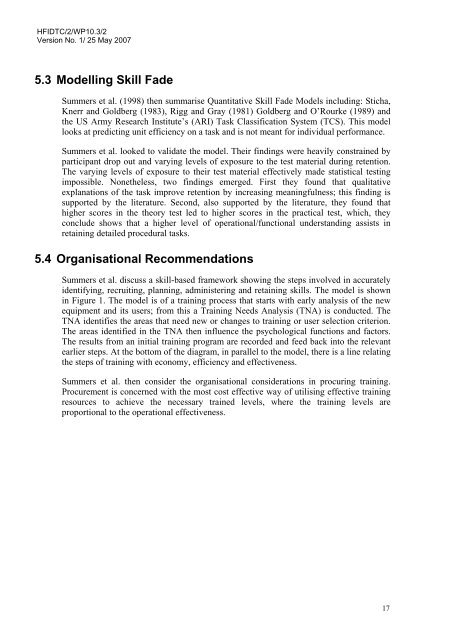Literature Review on Skill Fade - Human Factors Integration ...
Literature Review on Skill Fade - Human Factors Integration ...
Literature Review on Skill Fade - Human Factors Integration ...
You also want an ePaper? Increase the reach of your titles
YUMPU automatically turns print PDFs into web optimized ePapers that Google loves.
HFIDTC/2/WP10.3/2<br />
Versi<strong>on</strong> No. 1/ 25 May 2007<br />
5.3 Modelling <strong>Skill</strong> <strong>Fade</strong><br />
Summers et al. (1998) then summarise Quantitative <strong>Skill</strong> <strong>Fade</strong> Models including: Sticha,<br />
Knerr and Goldberg (1983), Rigg and Gray (1981) Goldberg and O’Rourke (1989) and<br />
the US Army Research Institute’s (ARI) Task Classificati<strong>on</strong> System (TCS). This model<br />
looks at predicting unit efficiency <strong>on</strong> a task and is not meant for individual performance.<br />
Summers et al. looked to validate the model. Their findings were heavily c<strong>on</strong>strained by<br />
participant drop out and varying levels of exposure to the test material during retenti<strong>on</strong>.<br />
The varying levels of exposure to their test material effectively made statistical testing<br />
impossible. N<strong>on</strong>etheless, two findings emerged. First they found that qualitative<br />
explanati<strong>on</strong>s of the task improve retenti<strong>on</strong> by increasing meaningfulness; this finding is<br />
supported by the literature. Sec<strong>on</strong>d, also supported by the literature, they found that<br />
higher scores in the theory test led to higher scores in the practical test, which, they<br />
c<strong>on</strong>clude shows that a higher level of operati<strong>on</strong>al/functi<strong>on</strong>al understanding assists in<br />
retaining detailed procedural tasks.<br />
5.4 Organisati<strong>on</strong>al Recommendati<strong>on</strong>s<br />
Summers et al. discuss a skill-based framework showing the steps involved in accurately<br />
identifying, recruiting, planning, administering and retaining skills. The model is shown<br />
in Figure 1. The model is of a training process that starts with early analysis of the new<br />
equipment and its users; from this a Training Needs Analysis (TNA) is c<strong>on</strong>ducted. The<br />
TNA identifies the areas that need new or changes to training or user selecti<strong>on</strong> criteri<strong>on</strong>.<br />
The areas identified in the TNA then influence the psychological functi<strong>on</strong>s and factors.<br />
The results from an initial training program are recorded and feed back into the relevant<br />
earlier steps. At the bottom of the diagram, in parallel to the model, there is a line relating<br />
the steps of training with ec<strong>on</strong>omy, efficiency and effectiveness.<br />
Summers et al. then c<strong>on</strong>sider the organisati<strong>on</strong>al c<strong>on</strong>siderati<strong>on</strong>s in procuring training.<br />
Procurement is c<strong>on</strong>cerned with the most cost effective way of utilising effective training<br />
resources to achieve the necessary trained levels, where the training levels are<br />
proporti<strong>on</strong>al to the operati<strong>on</strong>al effectiveness.<br />
17
















